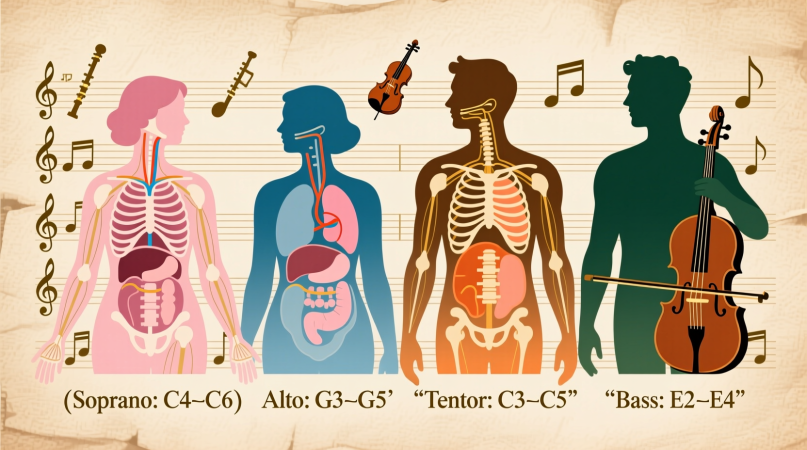
If you’ve ever joined a choir or read about vocal ranges, you’ve probably heard the terms soprano, alto, tenor, and bass. These are the four main voice categories most singers fall into. But what do they actually mean, and how do you figure out which one you are?
This guide breaks it down simply, so you can understand your own voice better and sing with more confidence.
What Do Soprano, Alto, Tenor, and Bass Mean?
These labels describe how high or low your voice naturally sits. Instead of just focusing on the very highest or lowest note you can hit, they help group singers into parts that sound best together in harmony.
- Soprano – Highest female voice.
- Alto – Lower female voice, warm and rich.
- Tenor – Highest natural male voice.
- Bass – Lowest male voice, deep and resonant.
Quick Voice Type Comparison
| Voice Type | Usual Gender | Comfortable Range | Sound Quality | Example Singer |
|---|---|---|---|---|
| Soprano | Female | C4 – A5 | Bright, agile | Ariana Grande |
| Alto | Female | F3 – D5 | Warm, rich | Adele |
| Tenor | Male | B2 – G4 | Clear, powerful | Freddie Mercury |
| Bass | Male | E2 – C4 | Deep, resonant | Johnny Cash |
👉 Want to test where your own voice sits? Try the Vocal Range Calculator to check your lowest and highest comfortable notes.
How They Work in Choirs and Music
- Sopranos usually carry the main melody because their high notes cut through clearly.
- Altos sing harmony lines just below, adding depth.
- Tenors often lead the male sections with ringing clarity.
- Basses provide the foundation, anchoring the group with low resonance.
Together, these four parts create the balanced SATB (Soprano, Alto, Tenor, Bass) choir structure that’s used worldwide.
Range vs. Comfort Zone (Tessitura)
Many beginners think their voice type is only about how high or low they can go. In reality, your tessitura—the notes where your voice feels natural—is more important.
For example, if you can reach a high C once in a while but feel comfortable singing mostly between G3 and G4, you’re more likely an alto or baritone than a soprano or tenor.
FAQs About Voice Types
What’s the main difference between soprano and alto?
Sopranos sing higher, often carrying melodies; altos sing lower harmonies with a richer tone.
Can someone switch between tenor and bass?
Some singers sit between categories, but your natural tessitura usually guides you toward one part.
Do women ever sing tenor or men ever sing alto?
Yes—voice types are flexible. Some female voices sit comfortably in tenor range, and countertenors can sing alto lines.
